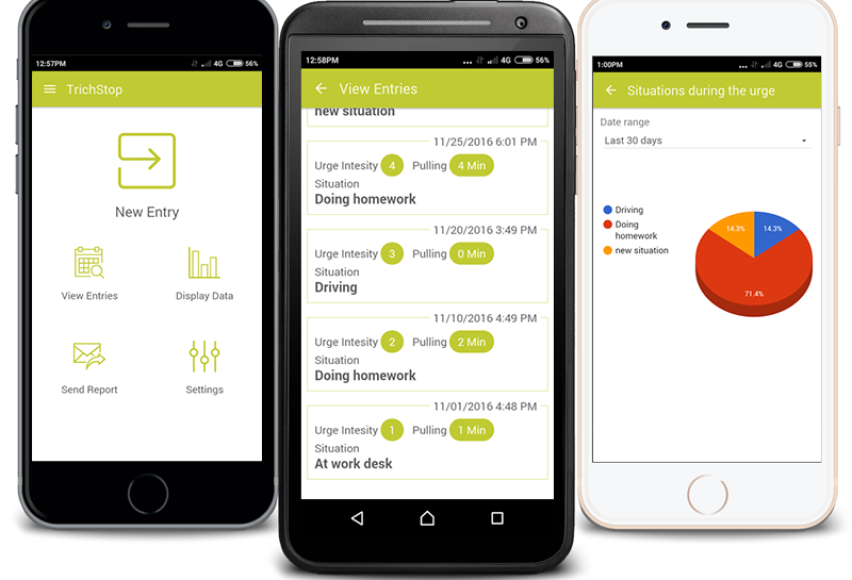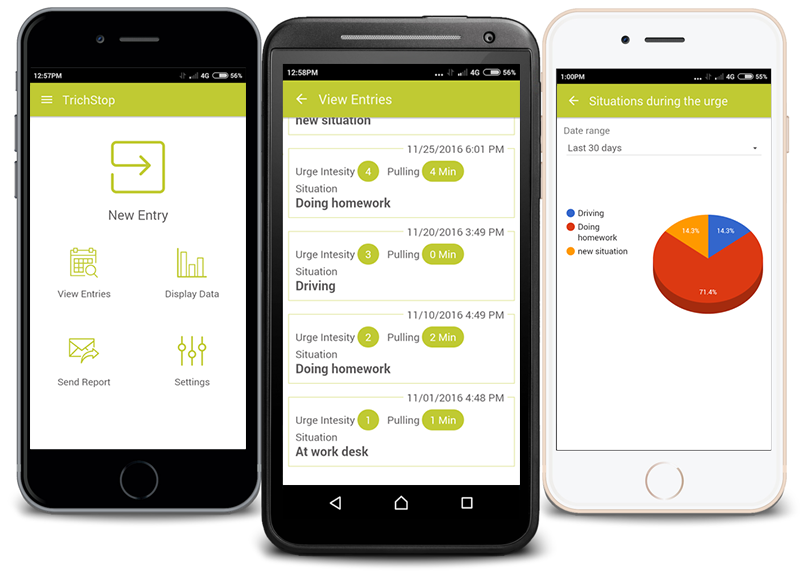Tracking your hair pulling can help reduce it

Online test
Find out the severity of your symptoms with this free online test
 Trichstop.com has developed a free self-monitoring and tracking app available to anyone to download on both android and apple stores. Tracking hair pulling is a mindful practice that can help in many ways.
Trichstop.com has developed a free self-monitoring and tracking app available to anyone to download on both android and apple stores. Tracking hair pulling is a mindful practice that can help in many ways.
A mindful practice
What do we mean by mindful practice? Mindfulness is the process of being present in the moment, aware of thoughts, feelings, and bodily sensations without judgment. Practicing mindfulness can help you separate of the behavior of hair pulling from your identity and objectively evaluate where you are and where you want to be.
Increase awareness
We think we know a lot about our habits, but tracking them offers revealing insights. In the initial stages of treatment, identifying habits, triggers, and behaviors related to hair pulling helps to formulate a treatment plan consistent with your goals. Think of tracking as a method of investigating how pulling hair affects your life.
- Recognize habits. Tracking will help show habits. Maybe there are times of day, locations, or life events that influence your pulling behaviors in ways that you may not notice. There are even devices and apps that will help you recognize your habits, especially if hair pulling is an unfocused activity, or something you do automatically without realizing it. (http://www.prevention.com/health/i-tried-wearing-a-tracker-to-stop-playing-with-my-hair)
- Awareness of triggers. Sometimes we are not aware of why we do what we do or what causes us to start. Triggers can include locations, people, events, or feelings. Once triggers are identified, you can do something about them.
- Awareness of how stress affects hair pulling. Tracking behaviors as well as thoughts, feelings, and events surrounding pulling will help you become more aware of trends in pulling behavior.
- Increased awareness of how much time is spent on hair pulling can be an eye opener as well, especially for unfocused behaviors.
As your awareness of your habits increased, you can make decisions about how you would like to change.
Take control
Recognizing patterns through tracking allows you to take steps to control it. For example, let's say you recognize that the compulsion to pull increases following being around certain people because it leads to stress. Then, you can experiment with different skills. You may decide to avoid those people or spend less time with them to see what happens. By tracking, you can determine if there is a difference. If you have to be around those people, you can experiment with different coping skills before, during, and after to see if those have any effect.
 Evaluation
Evaluation
Tracking hair pulling along the thoughts, feelings, and behaviors that go with it allows for objective evaluation. For example, if by tracking your habits you learn that you spend 15 hours per week pulling, one of your treatment goals may be to find ways to decrease it. Then, when you implement strategies and track your time, you may find out you decrease to 11 hours per week. Without tracking, you may feel like you have not decreased enough, but with tracking, you can note your progress and celebrate success no matter how small.
There are many reasons tracking pulling behavior can help during treatment. Not everyone stops completely, but tracking can help you on your way to feeling like you can control the behavior.
Online test
Find out the severity of your symptoms with this free online test
Start your journey with TrichStop
Take control of your life and find freedom from hair pulling through professional therapy and evidence-based behavioral techniques.
Start Now



